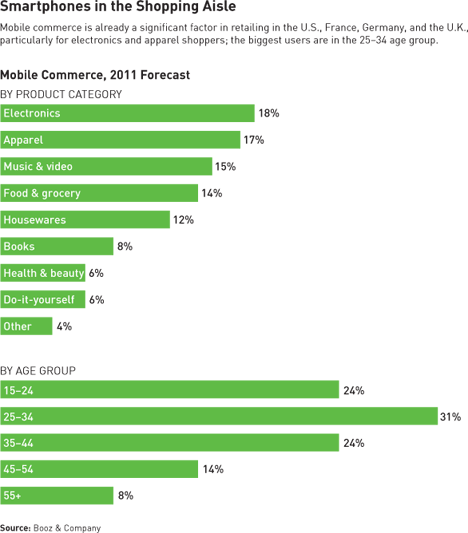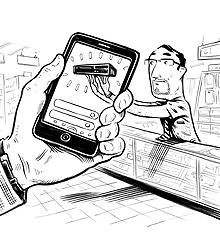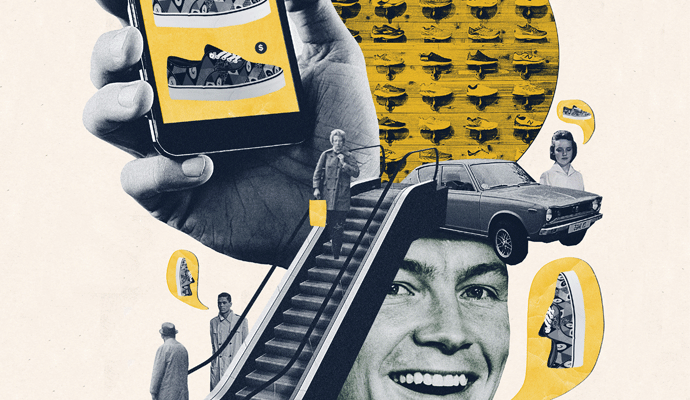The M-Commerce Challenge to Retail
As smartphones change shopping, merchants face a stark choice: Fall in behind their newly enabled consumers or fall behind altogether.
You may not have heard of Shopkick yet, but it’s one of the best examples of the dramatic changes facing retailers now. An application that runs on iPhones, Shopkick pays consumers “kickbucks” — reward coupons — just for checking in when they enter Best Buy, American Eagle, Macy’s, or other participating retailers. Additional kickbucks are available for performing particular actions — for example, scanning a poster on a store’s dressing room wall into the iPhone camera. The kickbucks can be redeemed for gift cards and donations to charitable causes. Moreover, when shoppers at Best Buy show their iPhones running Shopkick to the cashier, they receive instant discounts.
Combining the location-finding power of the global positioning system (GPS), the ubiquity of the cell phone, and the creativity of online marketing, Shopkick and many similar applications are altering the consumer landscape. At a time when retailers are struggling to reach customers, who have become more and more hesitant to spend in a soft economic environment, this new use of technology will divide retailers further. The early adopters of mobile commerce (or m-commerce, as this use of technology is called) will have greater opportunities to influence shoppers in real time as they build “in the moment” customer analytics capabilities. Lagging merchants will increasingly see customers browsing their aisles while tuning in to their smartphones to check reviews, compare prices, and make deals with competitors on the spot. In short, m-commerce blurs the distinction between websites and bricks-and-mortar outlets, linking disparate operations and making the Internet a pivotal sales engine for the first time for many retailers — and highly dangerous for others.
A Rapidly Expanding Market
Although a relatively new phenomenon, m-commerce is already beginning to make its mark. A recent Booz & Company survey of U.S. consumer usage and attitudes toward mobile commerce found that between 15 and 20 percent of consumers currently use their cell phones and personal digital assistants for price discovery and product comparison, and 25 percent expect to do so in the future. Ten to 15 percent of the revenues from retail are expected to be influenced by mobile applications this year, or as much as US$340 billion in total retail sales across the U.S. and the “E.U. 3” (France, Germany, and the U.K.), as the exhibit below shows.

These numbers will surely grow rapidly, if only because the penetration of smartphones (a category that includes the iPhone, Android, BlackBerry, and others) is expected to increase from 17 percent in the U.S. and 15 percent in the E.U. today to 74 percent and 43 percent, respectively, by 2014. By 2013, as many as half the consumers in a typical retail store will use their smartphones for shopping.
Some retailers are already racking up impressive sales from m-commerce. In July 2010, Amazon reported that annual global revenues from mobile devices, including its Kindle reader, had reached $1 billion. Likewise, eBay expects its 2010 mobile commerce revenue to be between $1.5 and $2 billion; one item is sold via eBay Mobile every two seconds. The incentives for fence-sitting retailers to join this movement are high, because m-commerce builds loyalty, and returning m-commerce customers purchase items three to four times as often as their e-commerce counterparts.
Meanwhile, new players such as the enormously popular Facebook are entering the field. In August 2010, Facebook launched its “Places” service, which allows the site’s 500 million users to disclose their current location on their home page. Retailers can tap into this feature to offer products, sales, and buying ideas. Consumers can vet pending purchases with their online network of friends, compare Web-based reviews and ratings, and see prices from a competing store down the street. American Apparel, Best Buy, Dell, Macy’s, Sears, and Walmart use Facebook in this way now. In the Booz & Company survey, upward of 85 percent of customers said that retailers should do more to integrate social networking into their m-commerce offerings.
A Synchronized Experience
In a truly mobile, digital marketplace, no channel exists in isolation. Instead, retailers will increasingly design fully integrated shopping experiences to cater to well-informed, digitally enabled consumers — creating, in effect, a new electronic retail ecosystem. Amazon’s mobile offering provides an apt illustration. The online retailer offers real-time cart synchronization across electronic and mobile channels; if you put a CD in your cart when shopping via smartphone, the CD will be there when you log in later from your desktop. On the mobile home page, Amazon provides personalized recommendations, shopping histories, easy access to product ratings and reviews, and product recommendations. Amazon’s most eye-catching m-commerce accomplishment is an application called Amazon Remembers. Consumers can take a picture of a product at a store (or, in fact, an item in their house), and the retailer will within minutes text them with links to similar products for sale at Amazon.
How are the most advanced bricks-and-mortar retailers coping with this kind of m-commerce–driven competition? By providing a mobile experience that keeps shoppers focused on the store they are in. For example, Walmart allows customers to search for ratings and reviews by scanning the barcode of in-store products into a cell phone. This tactic underscores another Booz & Company survey result: Conversion rates (turning browsing into sales) increase by as much as 240 percent when consumers view ratings and reviews while shopping — in this case, it was for orders under $200. Looked at from a more negative perspective, retailers that don’t give customers a way to get the purchasing insight they need from their own ecosystem and that don’t offer jazzy mobile shopping features will only drive their consumers to find reviews and offers someplace else, creating a chance for a competitor to, in effect, enter their store.
Best Buy has a still more ambitious approach. Its “twelpforce,” founded in 2010, is a large group of employees who answer customer questions posed on Twitter about brands and models. Most of these tweets are sent by consumers while they are in Best Buy stores.
The most innovative uses of m-commerce have yet to be invented. A high-end clothing retailer, for example, could develop a mobile app that allows customers to take pictures of outfits they like on the street or at work, mix and match items in virtual closets showing photos of the clothing in their physical closets, combine this set of information with recommendations from the retailer, and share possible purchases with friends via social networks to collect instantaneous buzz that will help them make their decisions. As this illustrates, the retailer of the not-too-distant future will have to stay on top of customer preferences from any number of sources of data — pictures, video, chat, and who knows what else — and serve up highly targeted offers at the right price to coax the consumer to buy a new blouse that she has been thinking about or that she just took a picture of while sitting at a café enjoying an espresso.
As the apps grow more sophisticated, anything that transpires on a smartphone — purchases, preferences, products viewed, and reviews — will become part of an ongoing digital log that influences the decisions consumers make and the types of catalogs and offers they receive. Bricks-and-mortar retailers will also synchronize e- and m-commerce activities with in-store point-of-sale systems, creating new levels of potential up-selling, cross-selling, and customer service.
Loyalty and Context
Currently, the least used multi-channel strategy is a well-integrated loyalty program. Best Buy’s “Reward Zone” program, which offers consumers points for purchases and targeted promotions that can be redeemed at stores or online, is one of the few that can be freely accessed in any sales channel. Yet according to the Booz & Company survey, 54 percent of consumers would like to have a mobile loyalty account that provides credit, points, and promotions across a variety of physical and virtual outlets.
With m-commerce just getting off the ground, retailers have many options. The Booz & Company survey offers some relevant insight. Respondents were asked to provide information on the mobile commerce features that they use — in homes, offices, and retail stores — along with the impact of those features on their final purchase decisions. The most commonly used application in homes and offices was taking a picture of a product to share with friends. In stores, consumers most frequently used their smartphones to view mobile ads, ratings, or reviews. They stated that ads changed their purchase decisions 38 percent more often in stores than at home or in the office.
Also popular is the ability to compare product prices among stores via smartphone. Consumers compare prices more often in stores than in the home or office, but the influence of this feature over the final purchase decision is consistent in all contexts. Researching product information via smartphone was also high on the list, regardless of the shopper’s location.
Play to Your Strengths
If you are a retailer seeking an m-commerce strategy, your first step should be to make a solid assessment of your own business. There is no universal, one-size-fits-all path. Rather, a successful strategy should take into account the relevant core technical capabilities of your company, the commercial channels in which you operate (big box or small format retail, e-commerce, kiosks, etc.), the competitive dynamics in your sector, and the current state of the art of m-commerce itself. (Remember, mobile technology is advancing almost daily.) In other words, a mobile strategy needs to adopt the face and persona of the business behind it.
Most retailers begin by leveraging their existing e-commerce capabilities (honed through product websites and supply chain experience) onto mobile channels with little customization. This, at least, gets you into the game and achieves some parity in the market. The next phase is the development of advanced m-commerce capabilities to drive revenue growth: attacking key categories, influencing shopper decision making, and shifting purchases away from competitors to claim market share.
In some cases, retailers should take an offensive strategy: injecting offers and product information into smartphone formats that crowd out competitors and directly affect consumer shopping decisions. For example, outdoor equipment and apparel maker North Face uses GPS and cell phone location data to create “geo-fences” in some areas of the United States. These virtual zones provide special purchasing incentives when consumers are near a retail store that sells its brand.
In other situations, a more service-oriented posture is appropriate to protect market share and enrich an already top-flight customer experience. Take IKEA’s use of augmented reality technology, which allows customers to create a virtual model of the room they are buying furniture for (by entering the dimensions) and then furnish it with 3-D models of items to see how well the pieces fit. Providing an experience like this not only is useful for shoppers but also keeps their attention on the store’s products and minimizes the chances that they will browse the mobile Web for alternatives.
In either case, a set of critical capabilities must be developed to enter this arena, including being able to work with third-party service providers such as Shopkick, Facebook, and Web ad placement and analytics firms AdNetwork, DataXu, and AdMob. In addition, there is the very real need to integrate these outward-facing m-commerce solutions with your own internal IT and marketing systems — the systems that currently gather customer information and analyze business intelligence. Indeed, m-commerce will strain traditional marketing analytics and systems, which are generally not prepared to act decisively on real-time data.
As the early adaptations show, mobile commerce implementations will be as different as the businesses that launch them. But there is a common end game of all m-commerce implementations that is as critical as the technology itself: Give customers an enjoyable, rewarding, and inventive channel in which to purchase your products and increase their loyalty. If that goal remains firmly in sight, your recently launched mobile application will soon become as ingrained in your customers’ habits as a 50-year-old catalog or a 20-year-old website. ![]()
Reprint No. 11105
Author profiles:
- Matt Anderson is a partner with Booz & Company based in Houston. His areas of expertise include customer experience, online strategy, social networks, multichannel retail and content, and B2B services.
- Nick Buckner is an associate with Booz & Company based in Houston. He supports growth strategies and transformation initiatives for retail consumer and digital clients.
- Stefan Eikelmann is a partner with Booz & Company based in Düsseldorf. He focuses on information and communication technologies and leads the firm’s related engagements in Germany, Switzerland, Austria, and Eastern Europe.
- Also contributing to this article were Booz & Company Partner Joseph Sims and Senior Associate Fabian Seelbach.




